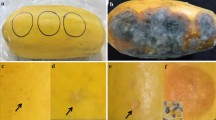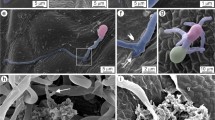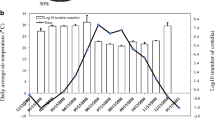Abstract
The infection process of Valsa mali var. mali (Vmm), causal agent of canker, in apple (Malus domestica cv. Fuji) tissue was investigated by light and electron microscopy. The germination pattern of conidia was similar on wounded or intact twigs, but there was a time delay on intact bark. On intact bark tissue, conidia swelling could be observed at 16 h post inoculation (hpi) and conidia germinated at 20 hpi, however, no infection was observed. On wounded twig surface, conidia swelled at 6 hpi, and germinated at 16 hpi. Direct penetration of germ tubes was observed by 20 hpi and the pathogen caused canker lesions 4 days post inoculation (dpi) on wounded twigs. Electron microscopy observation of the canker region showed that fungal hyphae mainly spread intercellularly causing severe tissue maceration and cell necrosis. By 15 dpi, hyphae colonized all bark tissues and xylem vessels and generated pycnidia on the canker region. Fungal colonization resulted in marked alterations in host tissues including plasmolysis and degeneration of protoplasts and cell walls. Based on enzyme- and immuno-gold labeling of cell wall components, pectinases were involved in pathogenesis of Vmm of apple tissue.





Similar content being viewed by others
References
Abe K, Kotoda N, Kato H, Soejima J (2011) Genetic studies on resistance to Valsa canker in apple: genetic variance and breeding values estimated from intra- and inter-specific hybrid progeny populations. Tree Genet Genomes 7:363–372
Adams GC, Roux J, Wiingfield MJ (2006) Cytospora species (Ascomycota, Diaporthales, Valsaceae): introduced and native pathogens of trees in South Africa. Australas Plant Pathol 35:521–548
Banko TJ, Helton AW (1974) Cytospora induced changes in stems of Prunus persica. Phytopathology 64:899–901
Berg RH (1990) Cellulose and xylans in the interface capsule in symbiotic cells of aetinorhizae. Protoplasma 159:35–43
Bessho H, Tsuchiya S, Soejima J (1994) Screening methods of apple trees for resistance to Valsa canker. Euphytica 77:15–18
Biggs AR (1989) Integrated approach to controlling Leucostoma canker of peach in Ontario. Plant Dis 73:869–874
Biggs AR (1990) Managing wound-associated diseased by understanding wound healing in the bark of woody plants. J Arboric 16:108–112
Cao KQ, Guo LY, Li BH, Sun GY, Chen HJ (2009) Investigations on the occurrence and control of apple canker in China. Plant Protect 35(2):114–116
Frens G (1973) Controlled nucleation for the regulation of the particle size in monodisperse gold suspensions. Nature 241:20–22
Gairola C, Powell D (1971) Extracellular enzymes and pathogenesis by peach cytosporas. J Phytopathol 72:305–314
Gao KX, Liu XG (1995) Review of researches on the Valsa canker of apple trees. J Hebei Forest Coll 10(1):87–91
Kang Z, Buchenauer H (2000) Cytology and ultrastructure of the infection of wheat spikes by Fusarium culmorum. Mycol Res 104(9):1083–1093
Kepley JB, Jacobi WR (2000) Pathogenicity of Cytospora fungi on six hardwood species. J Aboric 26:326–332
Knox JP, Linstead PJ, King J, Cooper C, Roberts K (1990) Pectin esterification is spatially regulated both within cell walls and between developing tissues of root apices. Planta 181:512–521
Lee DH, Lee SW, Chi KH, Kim DA, Uhm JY (2006) Survey on the occurrence of apple disease in Korea from 1992 to 2000. Plant Pathol J 22:375–380
Liu FC, Chen C, Shi XQ, Guo JG, Xing ZF, Zhang XW, Chen YX (1979) Studies on the latent infection of the causal organism of Valsa canker of apple. J Plant Protect 6(3):1–8
Liu XY, Lü S, Wang Y, Wang K, Li TH, Han ZH, Zhang XZ (2011) Evaluation of resistance of malus germplasms to apple canker (Valsa ceratosperma). J Fruit Sci 28(5):843–848
Reignault P, Kunz C, Delage N, Moreau E, Vedel R, Hamada W, Bompeix G, Boccara M (2000) Host- and symptom-specific pectinase isozymes produced by Botrytis cinerea. Mycol Res 104:421–428
Sakuma T (1990) Valsa canker. In: Jones AL, Aldwinckle HS (eds) Compendium of apple and pear diseases. APS, St. Paul, pp 39–40
Schoeneweiss DF (1983) Drought predisposition to Cytospora canker in blue spruce. Plant Dis 67:383–385
Suzaki K, Yoshida K, Ito T (1997) Pathogenicity to apple branch and phloridzin degrading activity of Valsa caratosperma isolated from some broad leaf trees including apple tree. Ann Rep Plant Prot 48:145–147
Svircev AM, Biggs AR, Miles NW (1991) Isolation and partial purification of phytotoxins from liquid cultures of Leucostoma cincta and Leucostoma persoonii. Can J Bot 69:1998–2003
Walton JD (1994) Deconstructing the cell wall. Plant Physiol 104:1113–1118
Wang L, Zang R, Huang LL, Xie FQ, Gao XN (2005) The investigation of apple tree valsa canker in Guanzhong region of Shaanxi province. Journal of Northwest Sci-Tech University of Agriculture and Forestry 33(suppl):98–100
Wang XL, Wei JL, Huang LL, Kang ZS (2011) Re-evaluation of pathogens causing Valsa canker on apple in China. Mycologia 103:317–324
Willison RS (1936) Peach canker investigations II. Infection studies. Can J Res 14:27–44
Zang R (2006) Studies on biological characters and pathogenicity of different isolates of Cytospora isolated from apple tree. Shaanxi, China: Northwest A&F University, Master thesis
Zang R, Huang LL, Kang ZS, Wang XL (2007) Biological characteristics and pathogenicity of different isolates of Cytospora spp. isolated from apple trees in Shannxi province. Acta Phytopathol Sin 37(4):343–351
Zang R, Li ZL, Ke XW, Wang XJ, Yin ZY, Kang ZS, Huang LL (2012) A nested PCR assay for detecting Valsa mali var. mali in different tissues of apple trees. Plant Dis, Accepted
Zhang JX, Bruton BD, Miller ME, Isabeit T (1999) Relationship of development stage of cantaloupe fruit to black rot susceptibility and enzyme production by Didymella bryoniae. Plant Dis 83:1025–1032
Acknowledgments
We are grateful to Dr. H. Buchenauer for correcting the grammatical and spelling errors as well as critical reading of the manuscript. We also thank Mr. Guoyun Zhang for technical assistance. Financial support by National Natural Science Foundation of China (30771396, 31171796), the Program for Agriculture (nyhyzx201203034-03),The Project from Shaanxi (2011KTZB02-02-02) and the 111 Project (B07049) is gratefully acknowledged.
Author information
Authors and Affiliations
Corresponding author
Rights and permissions
About this article
Cite this article
Ke, X., Huang, L., Han, Q. et al. Histological and cytological investigations of the infection and colonization of apple bark by Valsa mali var. mali . Australasian Plant Pathol. 42, 85–93 (2013). https://doi.org/10.1007/s13313-012-0158-y
Received:
Accepted:
Published:
Issue Date:
DOI: https://doi.org/10.1007/s13313-012-0158-y




